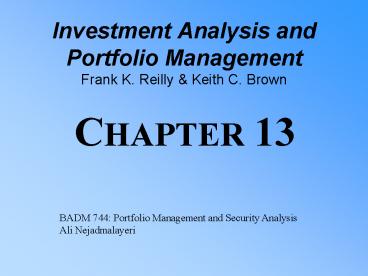Investment Analysis and Portfolio Management Frank K' Reilly - PowerPoint PPT Presentation
1 / 23
Title:
Investment Analysis and Portfolio Management Frank K' Reilly
Description:
New Debt issues. Market Valuation Using the Free Cash Flow to Equity (FCFE) Model ... Two-part valuation procedure. Market Valuation Using Relative Valuation Approach ... – PowerPoint PPT presentation
Number of Views:3803
Avg rating:3.0/5.0
Title: Investment Analysis and Portfolio Management Frank K' Reilly
1
Investment Analysis and Portfolio
ManagementFrank K. Reilly Keith C. Brown
CHAPTER 13
BADM 744 Portfolio Management and Security
AnalysisAli Nejadmalayeri
2
Applying the DDM Valuation Model to the Market
- The stream of expected returns
- The time pattern of expected returns
- The required rate of return on the investment
3
Applying the DDM Valuation Model to the Market
- Determinants of the Earnings Multiplier
- 1. The expected dividend payout ratio
- 2. The required rate of return on the stock
- 3. The expected growth rate of dividends for the
stock
4
Market Valuation Using the Reduced Form DDM
- Estimating k and g for the U.S. equity market
- The nominal risk-free rate
- The equity risk premium
- The current estimate of Risk Premium and k
- Estimating the growth rate of dividends (g)
- g f(b, ROE)
- ROE Net Income / Equity
5
Related Topics
- Equity risk premium
- Stocks or Bonds? Check AIMR forum
- Equity Valuation
- Systematic approach AIMR readings
- Quantitative Methods AIMR readings
- Technical Analysis
- Price charts CFA magazine
6
Estimating Growth Rate
- Growth rate of dividends is equal to
- Retention rate - the proportion of earnings
retained and reinvested - Return on equity (ROE) rate of return earned on
investment - An increase in either or both of these variables
causes an increase in the expected growth rate
(g) and an increase in the earnings multiplier
7
Return on Equity (ROE)
8
Market Valuation Using the Free Cash Flow to
Equity (FCFE) Model
- FCFE is
- Net Income
- Depreciation Expense
- - Capital Expenditures
- - D in Working Capital
- - Principal Debt Repayments
- New Debt issues
9
Market Valuation Using the Free Cash Flow to
Equity (FCFE) Model
- The Constant Growth FCFE Model
- The Two Stage Growth FCFE Model
10
Market Valuation Using Relative Valuation
Approach
- The price-earnings ratio (P/E)
- The price-book value ratio (P/BV)
- The price-cash flow ratio (P/CF)
- The price-sales ratio (P/S)
11
Market Valuation Using Relative Valuation Approach
- Two-part valuation procedure
12
Market Valuation Using Relative Valuation Approach
- Two major components of value
- 1. Estimating the future earnings per share for
the stock-market series - 2. Estimating a future earnings multiplier for
the stock-market series
13
Estimating Expected EPS
- Estimating expected earnings per share
- Estimate sales per share for a stock-market
series - Estimate the operating profit margin for the
series - Estimate depreciation per share for the next year
- Estimate interest expense per share for the next
year - Estimate the corporate tax rate for the next year
- Estimating Gross Domestic Product
14
Estimating Expected EPS Corporate Profits
- Alternative estimates of corporate net profits
- Direct estimate of the net profit margin based on
recent trends - Estimate the net before tax (NBT) profit margin
- Estimate an operating profit margin to obtain
EBITDA estimate depreciation and interest to
arrive at EBT estimate the tax rate (T) and
multiply by (1-T) to estimate net income
15
Estimating Expected EPS Aggregate Profit Margins
- Estimating aggregate operating profit margins
- Capacity utilization rate
- Unit labor costs
- Rate of inflation
- Foreign competition
16
Estimating Expected EPS Depreciation Expense
- Estimating depreciation expense
- time series trends
- estimate based on property, plant, and equipment
- sales and turnover
- depreciation
17
Estimating Expected EPS Interest Expense
- Estimating interest expense
- debt levels
- total assets
- expected capital structure
- interest rates
- subtract result from EBIT to estimate EBT
18
Estimating Expected EPS Taxes
- Estimating the tax rate
- depends on future political action
- multiply (1 t) times the EBT per-share to
estimate the net income per share
19
Estimating Expected EPS Multiplier for a Stock
Market Series
- Determinants of the earnings multiplier
- Dividend payout ratio
- required rate of return on common stock
- the expected growth rate of dividends for the
stocks
20
Determinants of Earnings Multiplier for a Stock
Market Series
- Estimating the required rate of return (k)
- inversely related to the earnings multiplier
- determined by risk-free rate, expected inflation,
and the risk premium for the investment - Estimating the dividend payout ratio (D/E)
- active decision or residual outcome?
- time series plots
- long-run perspective
21
Determinants of Earnings Multiplier for a Stock
Market Series (condt.)
- Estimating an Earnings Mutiplier
- An Example
- The Direction of Change Approach
- Specific Estimate Approach
- Calculating an Estimate of the Value for the
Market series
22
Other Relative Valuation Ratios
- Price to book value ratio (P/BV)
- Price to cash flow ratio (P/CF)
- Price to sales ratio (P/S)
23
Analysis of World Markets
- Individual country analysis
- analyze economy and security markets before
analyzing alternative industries or companies - macro techniques
- micro techniques
- technical analysis
- top down approach































